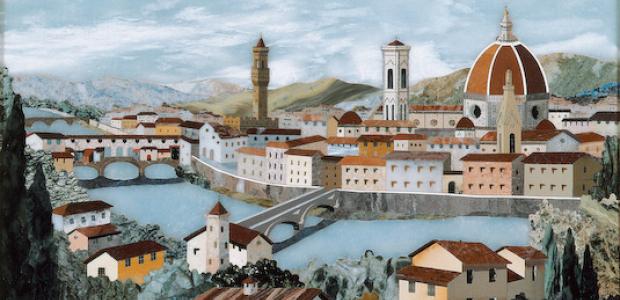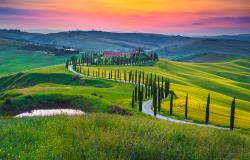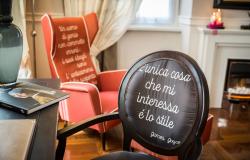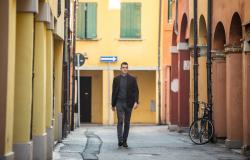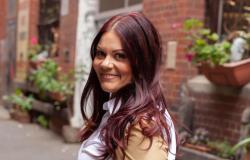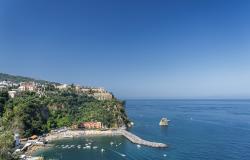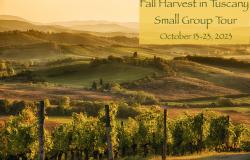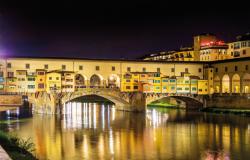In the middle of the 19th century, the English author John Ruskin wrote to his father from Tuscany: “You cannot conceive what a divine country this is just now; the vines with their young leaves hang as if they were of beaten gold”.
When I told a friend I was planning a book about the writers of Tuscany, she said, “It sounds like the assignment to die for”. Certainly, the prospect of spending a year or so meandering through Tuscany, retracing the footsteps of its writers, with occasional pauses for crostini and chianti, was an exciting one – although I hoped that the sacrifice would not be necessary.
My Tuscan pilgrimage began at Il Golfo dei Poeti, so named because it has been the haunt of poets for centuries, from Dante in the 14th century to D. H. Lawrence in the 20th. It was to this gulf that Shelley was sailing, to join his wife Mary, (the author of Frankenstein), when his boat capsized. His body was washed ashore two weeks later, just days before what would have been his 30th birthday. My intention was to traverse Tuscany from north to south, using only public transport in order to meet local people, stopping in the romantic city of Lucca – now doubly so because it was in its Roman Piazza dell' Anfiteatro that my wife and I became engaged.
With its ancient traditions of authorship, Tuscany seemed the obvious setting for a literary guide. The three greatest writers in Italian history: Dante, Petrarch and Boccaccio, were all native Tuscans, and the region has been a magnet and an inspiration to northern European writers since the arrival there of the English poet, Geoffrey Chaucer, in 1373. I was happy to follow.

I fell in love with Tuscany one sunny February morning many years ago as I stood outside Florence’s magnificent Cathedral. I was there studying Italian art of the 14th century – what Italians call the trecento. Now fortunate enough to live just a few hours’ train journey away, I have been back many times, but have never tired of the city or its artistic treasures.
Not only is Florence the cultural and political heart of Tuscany, it is a vibrant financial centre, whose very name became the first international unit of currency – the fleurin or florin – seven centuries before the Euro. The city has been the prime destination of itinerant authors: Elizabeth Barrett Browning lived and died there, and Charles Dickens, in his Pictures from Italy, called it, “a city of rich forms and fancies”.
 In a little street near the Cathedral, I came across a strange memento of Dante: a huge block of marble on which he is rumoured to have sat while contemplating the cathedral. Dante’s seat has since supported a number of poetic posteriors, (including –numbly – my own). Robert Browning’s has polished it, as has Wordsworth’s, when he wandered lonely through Tuscany in 1837. Eight years later, Dickens sat there, describing the experience in Little Dorritt.
In a little street near the Cathedral, I came across a strange memento of Dante: a huge block of marble on which he is rumoured to have sat while contemplating the cathedral. Dante’s seat has since supported a number of poetic posteriors, (including –numbly – my own). Robert Browning’s has polished it, as has Wordsworth’s, when he wandered lonely through Tuscany in 1837. Eight years later, Dickens sat there, describing the experience in Little Dorritt.
But Florence was not every British writer’s cappuccino: the Welsh poet Dylan Thomas hated it. “I am awfully sick of it here”, he wrote, “drinking chianti in our marble shanty” – and moved on to Elba. Others selected their own favourite locations: Ernest Hemingway chose medieval Siena; Lawrence precipitous Volterra, Muriel Spark rural Cortona, and Byron Pisa, of the vertically-challenged tower. Pisa almost lost its main tourist attraction during the Second World War, when an American group commander, deciding that the only way to foil German snipers would be to destroy the tower, ordered up the necessary heavy artillery. Fortunately, he was ordered to another position before his plan could be carried out and the tower survived– as did the commander.

With onset of the Grand Tour, that aristocratic gap year with which noble British families hoped to round off the classical studies of their sons by exposing them to Europe’s cultural treasures – and a variety of socially transmittable diseases - the trickle of migrant writers that had begun with Chaucer became a stream; and with the advent of affordable travel, the stream became a torrent. The literary exodus shows no sign of abating.
The authors came from various countries: from France, Alexandre Dumas; from Germany, Goethe; Hans Christian Anderson from Denmark, and from Russia, Dostoevsky and Tchekhov. The American invasion began early in the 19th century with poets and novelists such as Longfellow, Mark Twain, Henry James, Sinclair Lewis and John Steinbeck. But they were all far outnumbered by the British: the Shelleys, Lord Byron, Charles Dickens, Thomas Hardy, E.M. Forster, Muriel Spark, Dylan Thomas - and many more.
Migrating writers have found in the Tuscan people and landscape an inexhaustible source of characters and settings. Few expatriate literati returned home without the green shoots of their “Italian novel” in their baggage: Lawrence, with Aaron’s Rod, George Eliot with Romola, Forster with A Room with a View.

What was it that brought all these poets, novelists, biographers, playwrights and historians to Tuscany? One attraction was health: it was widely believed – and endorsed by the likes of the poet Elizabeth Barrett Browning - that the Mediterranean climate offered relief from respiratory ailments. Many struggling writers found that they could make their pounds or dollars go further in Italy: American author Nathaniel Hawthorne’s house on a southern hill overlooking Florence, was ‘big enough to quarter a regiment, with a separate suite of apartments for each member of the family”, cost him 28 dollars a month - including linen and silver. Others came seeking freedom from the constraints of English society: “Italy does not judge”, wrote Lawrence, (whose novel, Lady Chatterley’s Lover, was published in Florence 41 years before the English publication.)
 I was reluctant to leave the divine country. It had been a fascinating journey: discovering along the way writers who were strangers to me, and, through them, previously undiscovered parts of Tuscany; learning, like Kipling, Something of Myself, and observing that, despite wars, invasion, pestilence and plague; Garibaldi, Mussolini and Berlusconi – Tuscany itself remains stubbornly unchanged.
I was reluctant to leave the divine country. It had been a fascinating journey: discovering along the way writers who were strangers to me, and, through them, previously undiscovered parts of Tuscany; learning, like Kipling, Something of Myself, and observing that, despite wars, invasion, pestilence and plague; Garibaldi, Mussolini and Berlusconi – Tuscany itself remains stubbornly unchanged.
 Ted Jones was born in Liverpool, England and has lived and worked in New Zealand, Australia, London, Philadelphia and France. He currently divides his time between Nice, France and Windsor, England. He is a free-lance writer whose journalistic output is wide-ranging. His travel articles have appeared in publications on both sides of the Atlantic, including British magazines Choice, The Lady, Wanderlust, France, Yesterday and Living France, and American publications such as France Today, Writers' Journal, Transitions Abroad and Voyageur. His articles on business management have been published worldwide in several languages and his short stories and poetry have won a number of awards. As a writer for The Guardian he has published articles on subjects as diverse as modern jazz and horse-racing. He is the author of The French Riviera: A Literary Guide For Travellers (available on amazon.com
Ted Jones was born in Liverpool, England and has lived and worked in New Zealand, Australia, London, Philadelphia and France. He currently divides his time between Nice, France and Windsor, England. He is a free-lance writer whose journalistic output is wide-ranging. His travel articles have appeared in publications on both sides of the Atlantic, including British magazines Choice, The Lady, Wanderlust, France, Yesterday and Living France, and American publications such as France Today, Writers' Journal, Transitions Abroad and Voyageur. His articles on business management have been published worldwide in several languages and his short stories and poetry have won a number of awards. As a writer for The Guardian he has published articles on subjects as diverse as modern jazz and horse-racing. He is the author of The French Riviera: A Literary Guide For Travellers (available on amazon.com